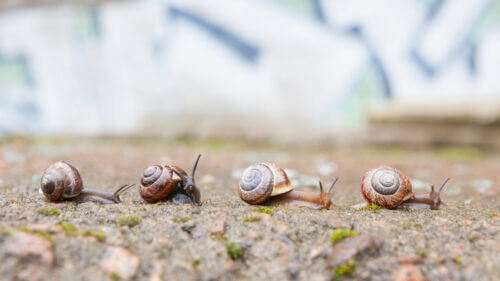Snails appearing with the shooter aroused the curiosity of Veronica who asks where do they disappear in the summer?

The snails that appear with the shooter aroused Veronica's curiosity, who asks where do they disappear in the summer?
They do not disappear but sleep dug under dirt, stones and other hiding places during the summer. We've all heard of the hibernation of the bears - the one whose awakening is immortalized in countless National Geographic films, but it turns out that the grizzly bear is nothing more than a public relations prat: the aestivation of the snails in the garden is an equally sophisticated mechanism. who summed up his first impression of the Land of Israel with the words "a great place to dry laundry". An environment where laundry dries easily poses a survival challenge for a mollusk, that is, a gel that is more than 80% water. The first protective measure is sealing the opening with a plug made of chalk. Hermetically closing the shell does not allows air to enter and the snail switches to anaerobic respiration, i.e. to produce the necessary energy by breaking down sugars without oxygen (in a similar way to muscles during prolonged aerobic effort). evaporates first) and the snails slow down the loss of water during the dry period by increasing the concentration of sugar and glycerol dissolved in the body fluids. Measuring the rate of evaporation from a snail soaked in summer hibernation revealed that it is able to survive up to 4 years of dryness. Such impermeability against evaporation does not allow the cooling of the body and indeed "our" snails are resistant Much more heat resistant than their European relatives and able to withstand sauna conditions of 50⁰C. A comparison between the 5 species of land snails that share the country revealed that the means of defense are refined the further south the snail is. in the species Sphincterochila boissieri Inhabiting the northern and central Negev, it was found, as expected, the best adaptation to dryness: the snail is larger than its northern brothers, so the surface area is small in relation to the volume, the shell opening is small, the calcareous cover is the most airtight and it burrows to a depth of 5-10 centimeters in the summer season. Desert snails are also the fastest to respond to environmental desiccation. Some species of snails in the Mediterranean climate zone prefer to climb plants instead of burrowing for summer hibernation, thus preventing heat transfer by conduction from the hot soil. These snails tend to group together so that the snails in the center of the cluster are protected from radiation and drying winds.
There are other animals in Israel that hibernate in the summer
The snails are not the only ones who pass the Israeli summer in hibernation: the slugs they dig in, cover the soil around them with mucus that prevents evaporation and coil their bodies into a tight flop. Thus, with a minimum of exposed surface area, they can survive 7 months of dryness and return to the surface of the ground with the shoot. The summer problem is simpler for those whose life expectancy is short: instead, they spend the dry season as eggs or pupae that are not active anyway and direct the active life forms: larva and adult to days abundant with water.
Summer hibernation is also common in amphibians: in Israel, the brown toads and newts burrow and fall asleep, and in the deserts of central Australia, a frog called the catchy Cichlorna platycephala makes sure to fill its water before going to bed. The frog stores about 100 ml of fresh water, which is half of its body weight, in its bladder, and thus, in its alcove lined with its skin, it can wait dormant for up to 5 years, waiting for the redeeming rain. Aboriginal Australians Learn to find and use these natural waters when thirsty.
Did an interesting, intriguing, strange, delusional or funny question occur to you? sent to ysorek@gmail.com
Thanks to Dr. Guy Shion for his help
More of the topic in Hayadan:
